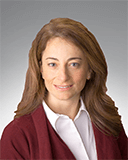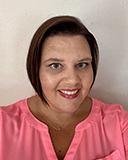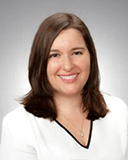Voiceover: This podcast is for informational and educational purposes only. It is not medical care or advice. Clinicians should rely on their own medical judgements when advising their patients. Patients in need of medical care should consult their personal care provider. Welcome to "That's Pediatrics", where we sit down with physicians, scientists, and experts to discuss the latest discoveries and innovations in pediatric healthcare.
Dr. Allison Williams: Welcome to That's Pediatrics. I'm Alli Williams, one of the pediatric hospitalists here at UPMC Children's Hospital of Pittsburgh.
Dr. Sameer Agnihotri: I'm Sameer Agnihotri. I'm an assistant professor in the department of neurological surgery.
Dr. Williams: We are so excited today to be joined by Dr. Ericka Fink and Shannon Snatchko to talk about the CIRCLE program. Dr. Fink is a board certified pediatric critical care medicine physician who works here in our department of pediatric critical care medicine in the ICU, and Shannon Snatchko is the nursing administrator for the CIRCLE program. Welcome, and thank you so much for being here with us. Tell us a little bit about this CIRCLE program. What is it and how did it develop?
Dr. Ericka Fink: Well, maybe I'll take that one on. The CIRCLE program stands for critical illness, recovery for children, and it all started as a response to something that's becoming more well known amongst the pediatric critical care community. Something called PICS-P, which is another acronym that stands for Post Intensive Care Syndrome for Pediatrics. As mortality rates in the PICU have gone down to 1.5, 3%, which is amazing, over the past 20 years, we've realized as a field that we really care about how children are surviving now that we're able to help them survive. We want them to have the best quality of life and the best functioning that they could possibly have, and we want their families to be equipped, to care for them longitudinally, and that they get all the support they need to reach their goals.
And so, where does it start? It really starts over 10 years ago when I realized I didn't really know what a physical therapist could do for children in the ICU. I had patients who desperately needed help with functioning better, but I didn't know when to call them, what they should be doing? What's safe. How can we make them better, faster? Those kinds of questions led to a small research study where we found we only utilized them and consulted them, I should say, for the sickest kids in the more obvious cases and quite late in their ICU course. It had me wondering, should we be involving them earlier in patients care and family care? I was able to get an award from the Patient-Centered Outcomes Research Institute or PCORI, and we conducted a three-center trial of early, meaning within 72 hours, of physical occupational and speech therapy consultation versus usual care, which was about seven days into a hospital stay to see whether interventions were safe and effective.
Is it feasible? What barriers were there to providing these types of care? This was conducted in children with neurocritical illnesses of all kinds, like trauma to the brain or cardiac arrest and resulting hypoxic damage. Children with status epilepticus for various reasons or tumors and what we found because we under enrolled. We couldn't tell if it would improve outcomes, I guess, at six months, but what we found was that it seemed to be relatively safe and feasible. We gathered this incredible multidisciplinary group of champions together that included the PT and speech therapists themselves, as well as our Rehab rehabilitation colleagues like Amy Houtrow, became an incredible champion for this program Amit Sinha and others. At the end of this, I realized I didn't want it to stop. I wanted to translate whatever we could learn into a clinical program.
So that's what we did. That was the beginnings of CIRCLE in about 2017. We started with just, what can we do for free? We didn't have funding. We had a different name at the time, but what we did was we decided at least once a week, we're going to get together with different ancillary services and add to our group nutrition, child life, social work. Anybody really who cares for these patients in this sort of way and review each child's current and relatively soon future needs or care coordination needs to recover.
We started that on Mondays and we'd bring in the ICU physician, whether the attending or the fellow, and we ran the list and hit the important points. As you might imagine, it's hard to do this in an hour. We've been doing this for over four years and Shannon's been, Shannon and Dr. Sarah Rubin who's my colleague, have really taken over running these rounds and making sure kids are getting early PT and OT consults. They're making sure kids' nutritional status are optimized and really communicating with the teams, what's needed to help these kids get ready for what's next?
Dr. Agnihotri: Very fantastic. You highlighted it really nicely, but could you expand upon some of the patients that you interact with and the families and-
Dr. Fink: Yeah. Well, I should mention that the second part of CIRCLE really just started when Shannon got here and that was last summer where we were able to obtain some funding from a family that donated to the Foundation here at Children's Hospital, which really was a big breakthrough for us because that meant we had someone who could be a point person for our longitudinal outcomes program.
I'm an ICU doctor. I don't run a clinic. It's not necessarily that I want to run a clinic, but we have these wonderful partners, as I mentioned before, in Rehab who already have some clinics where they follow kids up like Dr. Jason Edinger's Acquired Brain Injury Clinic. It's multidisciplinary, already in place, and just the general Rehab clinics. We thought we could partner with Rehab and follow patients longitudinally to really see that they're, I guess, what kind of new impairments or issues they're having and make sure that they're connected with all the different services they need to recover past the ICU doors. Maybe Shannon can elaborate a little bit on the kinds of patients that she's seeing.
Shannon Snatchko, MSN, RN, CCRN: Sure. Sure. We launched our program in September, very intentionally starting small as we were launching. We started with just neurocritical kiddos who were admitted through the PICU where I got to meet them in the PICU and previously a PICU nurse. I worked alongside Dr. Fink for nine years in the ICU. It's a familiar place for me, but definitely a brand new role. I never got to see what happened once they left the PICU, which was always a struggle of, we see these kids in their sickest times. I was really excited to transition into this role where we could follow them longitudinally and really get to see them beyond the ICU. I get to meet them in the ICU, introduce them to our program, really get a rapport with the family. Then we've intentionally grown slowly.
We started including ECMO patients and we are right on the edge here of expanding to a larger population, including our septic, our mods, ards kiddos who are spending a longer time in the ICU and are at higher risk for the PICS-P and the effects of PICS-P. I get to meet them there and then follow along with them. We see them in the clinics, as she mentioned. We pop in and when I meet them, I introduce them to our program, but we also ask them to fill out questionnaires about their baseline functions, specifically about their cognitive, emotional, physical? How's school going? Sleep?
Then we can ask them very similar questionnaires prior to their appointment at one of the clinics, and we can compare those baselines to maybe three months post-injury or post ICU stay. We can really hone in on any areas that they're not plugged into with all the great resources through Children's, their community, any areas of social determinants of health that maybe wasn't an issue baseline, but now has become an issue that we can work with our Social Work or Supportive Care. It's really very encompassing in terms of meeting their needs, not just the child's need, but also the family is really important as well.
Dr. Williams: It sounds like this is a program that really initiated, obviously in the ICU as this is the home base, but as you mentioned, children that experience these traumas are surviving and thriving much longer, which is wonderful. How does the transition happen when they leave the ICU and then they go to the clinics? Do you continue to call the families, or how long do you participate in the care of the families once they leave the ICU?
Ms. Snatchko: That's really up to the families. This is certainly a voluntary program, but we offer to follow them for up to a year so that we can continue to check in, at least on that first visit into one of the clinics in person. A lot of our families have also agreed to allow us to virtually follow them beyond that three months. We can see them virtually in six months and 12 months as well, or sooner if they feel that, that's needed and continue to follow along those questionnaires, to make sure that things are progressing in the right direction or nothing new has cropped up since we've seen them in clinic.
Dr. Fink: I'll just add to that a little bit. The reason why we thought up to a year, there's some evidence out there that shows, well, first of all, care is just not coordinated very well after critical illness. Sometimes it's coordinated by a PCP who doesn't have a lot of experience taking care of critically ill children, or the child has a specialist and maybe they're paying more attention to one organ or to one particular part of PICS-P but not others, which is wonderful but we try to be a, I guess, multidisciplinary, but also comprehensive in looking at different stages of recovery, because sometimes like Shannon said, emotional health problems don't come until later. When a child goes back to school, they might have new behavioral concerns, or I had experience with a family where they thought their child was doing fine, but then they had a memory issue.
Some of these things come up later and these needs might not always be present at discharge, I guess. There's really nobody that's following them from an ICU perspective longitudinally to coordinate this. I think with our partners in Rehab, we're able to use their expertise and just do these warm handoffs. Hopefully soon, we'll be able to have some electronic dashboard, that's one of our goals, that pops up in the app. It can pop up in Cerner and really show everybody who's caring for the child, how they're doing from all these different perspectives and what care they're receiving for them.
Dr. Agnihotri: Right. It's such an important program. I guess one of the things is you've grown this organically. Over the next five to 10 years, do you see increasing your longitudinal time or do you want more different types of expertise to help you?
Dr. Fink: I think that's a great question. Shannon said, we are following kids in one of the Rehab clinics at three months, approximately. Then we think that it's a big burden to ask families to come back to the hospital to visit us for sometimes multiple services asking for this. We're putting together a virtual telehealth follow-up clinic for six and 12 months. The families want to continue to participate and see a value in that. We're also expanding to kids who have different types of sepsis and organ dysfunction and those kids often have underlying problems like cancer or transplant. We're working together with those services to make sure we don't have any overlap or we're not doing anything that they're already doing in terms of follow-up that we're providing a unique service.
Dr. Williams: This program provides so much support for patients, but also for the families of the patients, because as you mentioned, there's not only the physical trauma that happens, but there's most certainly emotional trauma. I know sometimes the colloquialism is you've been “PICU-ized” or “NICU-ized” when you've been in an ICU setting and it is very traumatic. Is there a way that families who are a part of this program are able to connect with each other to provide emotional support for each other as well?
Ms. Snatchko: Yeah. We're in the very early stages of creating a family advisory board and seeing how that would look in terms of direction for our program, what families would think would be valuable? We're hoping to speak with those families who want to engage in that, to see if it would be helpful to create a community of families that could help support each other. Certainly, we've had some early feedback that families, I wish I would've known things, that are unique to those family experiences, not from a healthcare provider who can warn them about things, but we don't certainly have that perspective to offer.
Dr. Fink: Yeah, another part of what Shannon's trying to do and initiate is some more tools for family education. We already have some handouts, including one that's in a PICU journal that was developed between Child Life, one of our fellows in the PICU, and Physical Therapy and with original art and space for doodling, or also lined papers for taking notes or just journaling. There's also a tear-out sheet about PICSP and what it means and following up for the family and one for the PCP, and a glossary of different PICU terms. That's one piece of educational material that was developed thanks to a Beckwith grant. Shannon's goal is to, maybe I'll let you say.
Ms. Snatchko: Yeah, so I have a background, my master’s is in nursing, but it's specialized in education so I definitely have a passion for that. I definitely see that we have a need to better educate our families beyond just written material. My big goal would be to eventually develop a digital library that contains just bite size animated videos that break down PICSP and really can be better digested for families at any point of time. We know that families get so much information while they're in the hospital. It's really hard to know how much they're absorbing and retaining so that they could really access this library at any point of their recovery when it's relevant to them and not have to worry about handouts and keeping track of things like that.
Dr. Fink: Just to add on that, in addition to family input and education, we're looking to also get tied into the primary care community here at Children's and Western PA and arrange for some talks on PICS-P and what it is, and what to be concerned about when providers have these children come into their clinics for the first time?
Dr. Williams: How can primary care providers right now get in touch with your program? How can we help spread the word besides this podcast, which hopefully will help spread the word for this program, but what else can the Children's Hospital of Pittsburgh community do to help support this program?
Dr. Fink: Well, that's a great question. Thank you. I think stay tuned in the next few months. We're going to be lining up a lunch talk with the CCP clinic, thanks, CCP clinics. We might then, after seeing how that goes, get in touch with the wider network that's here in Western Pennsylvania to do some educational activities together. We do have a website on CHP that's... What is it? www.chp.CIRCLE (NOTE: The correct address is www.chp.edu/our-services/circle), and you can actually download our journal there. You could see the people that are involved in administrating this program. You can also read about PICS-P there as well. We welcome anyone to email us and our email address…
Ms. Snatchko: CIRCLE@chp.edu.
Dr. Williams: This program is so innovative and it's something that I, as a hospitalist, haven't heard of. I'm so glad to have the opportunity to learn about this program because as you expand your patient population, I assume others within the hospital that work on the acute care floors, but not necessarily ICU, will get more of an opportunity to assist your program and assist these patients. Is this program unique to our hospital or are there other programs like this throughout the nation?
Dr. Fink: Yeah. Another great question. There's a movement in the peds critical care community, at least that I'm engaged with, people doing research on these topics, people that are just caring for these patients. There are a couple of programs that sprung up a couple of years ago. One in St. Louis, one in Oregon in their PICUs. They're focused on the neurocritical care population and have neurologists that are pretty much embedded in their PICU. Between a PICU and a neurology attending, they follow kids long-term. They already have a clinic. They're not quite as multidisciplinary as Dr. Edinger's clinic, but they found it extremely valuable to have behavioral health as well as a neuropsychologists for going back to school, at least available in their clinic for their follow-up patients. They also do a standardized battery of questions just to look at functioning over time and also to support what kind of consultants are needed.
I know that other PICUs have programs that are in development too. Although we're not the first one out there, I think we're really comprehensive and we're also one of the only ones I know partnering with Rehab who really have an amazing understanding of the outpatient landscape for getting support for recovery. They're just built-in multidisciplinary collaborators like we are in the PICU. Ultimately, you had asked, what do we want over the next five to 10 years? I'd love for this to just be embedded as part of what we do for kids on the floor too.
PICS-P implies that these types of impairments are only occurring in children who have critical illness, who are certainly at high risk, but they're certainly patients who have long stays or infections or that might have emotional, physical, cognitive problems after their hospital stay, without touching the ICU. I'm really glad to bring this to light to your group and I'd be happy, again, if anyone wants to invite us to come and just chat about PICSP and our CIRCLE program, we're very willing to do that, but ultimately, I'd love to just see it be a hospital wide program where we really engage in following our patient and family outcomes and truly break down the barriers of these different spaces. ICU floor, ward, home, wherever they are, school.
Dr. Agnihotri: Right. You're addressing this huge problem by getting people to work outside of silos, right?
Dr. Fink: Yes.
Dr. Agnihotri: At an Institute and this is wonderful how you've grown this program and at the national level, other people are popping up. Do you envision national conferences or associations coming out of this because this is a concern and this is amazing how you guys have addressed it. You guys could serve as a template for other hospitals in other cities that might want to get this program going, because the results have been fantastic.
Dr. Fink: Love that question. I have to tell you if there's anyone listening that wants to help support our moonshot idea of developing a collaborative amongst PICUs and different institutions, please just call or email us anytime. Yes I did submit that as a moonshot idea. Obviously, you want to take care of your own population first and get things running and understand what works and doesn't work in your own institution that may not completely apply to another one.
For example, I have friends at other institutions that are interested in collaborating with us in research. We can think about interventional trials or getting more information out there about PICSP to patients, families, and the science community at large. Yeah, there already exist some groups thinking about this in terms of research but I think in terms of a clinical collaborative, that doesn't quite exist just yet like it does, for example, for the cardiac ICU community, pediatric cardiac. You might have heard of the PC4 collaborative run out of the University of Michigan. That's been ongoing for several years and it's very much about focus, mostly, on the ICU piece and quality control, quality implementation, getting the best outcomes possible. That's a huge success and it takes, I'm sure, substantial resources to start up and maintain that. Would love to see something like that for the PICU community.
Dr. Williams: We are so looking forward to, hopefully, hearing great things from your program very soon and watching it continue to grow. Would you all mind sharing just one more time at the end of our podcast, your email, so that folks who are listening to this don't have to go back to minute, whatever it was, to make sure that they can actually get in touch with you if they have questions or want to hear more information about it, as well as any social media handles that you all might have. It sounds like Shannon, what is it? www.chp.edu/our-services/CIRCLE for the website. Then what was your other email address, Shannon?
Ms. Snatchko: Our email address is CIRCLE @chp.edu.
Dr. Fink: Thank you so much. It was a joy to be here and discuss the CIRCLE program.
Dr. Agnihotri: Fantastic.
Dr. Williams: Thank you so much for listening and we'll see you next time on That's Pediatrics.
Voiceover: You can find other episodes of That's Pediatrics on iTune, Google Play Music and YouTube. For more information about this podcast or our guests, please visit chp.edu/thatspediatrics. If you've enjoyed this episode, please be sure to rate, review, and subscribe, to keep up with our new content. You can also email us at podcast.upmc@gmail.com with any feedback or ideas for topics you'd like our experts to cover on future episodes. Thank you again for listening to That's Pediatrics. Tune in next time.










 Shannon M. Snatchko, MSN, RN, CCRN, is the nurse coordinator for the CIRCLE program at UPMC Children’s Hospital of Pittsburgh. She earned her master’s of science in nursing, specializing in education and leadership from Carlow University. She has been a nurse for 13 years, with nearly 10 of those having been her at UPMC Children’s Hospital and 9 of those years as a bedside nurse in the PICU. During her time in the PICU, Shannon was part of a team that collaborated with the University of Virginia Children’s Hospital and AdventHealth for Children in Orlando to start their pediatric liver transplantation programs.
Shannon M. Snatchko, MSN, RN, CCRN, is the nurse coordinator for the CIRCLE program at UPMC Children’s Hospital of Pittsburgh. She earned her master’s of science in nursing, specializing in education and leadership from Carlow University. She has been a nurse for 13 years, with nearly 10 of those having been her at UPMC Children’s Hospital and 9 of those years as a bedside nurse in the PICU. During her time in the PICU, Shannon was part of a team that collaborated with the University of Virginia Children’s Hospital and AdventHealth for Children in Orlando to start their pediatric liver transplantation programs.
